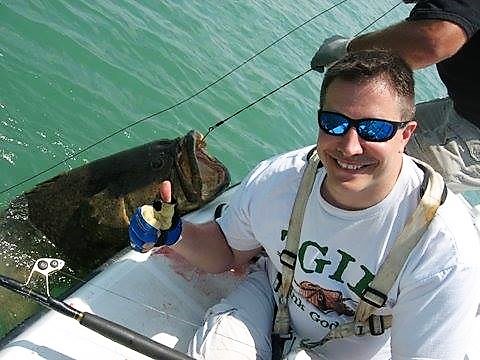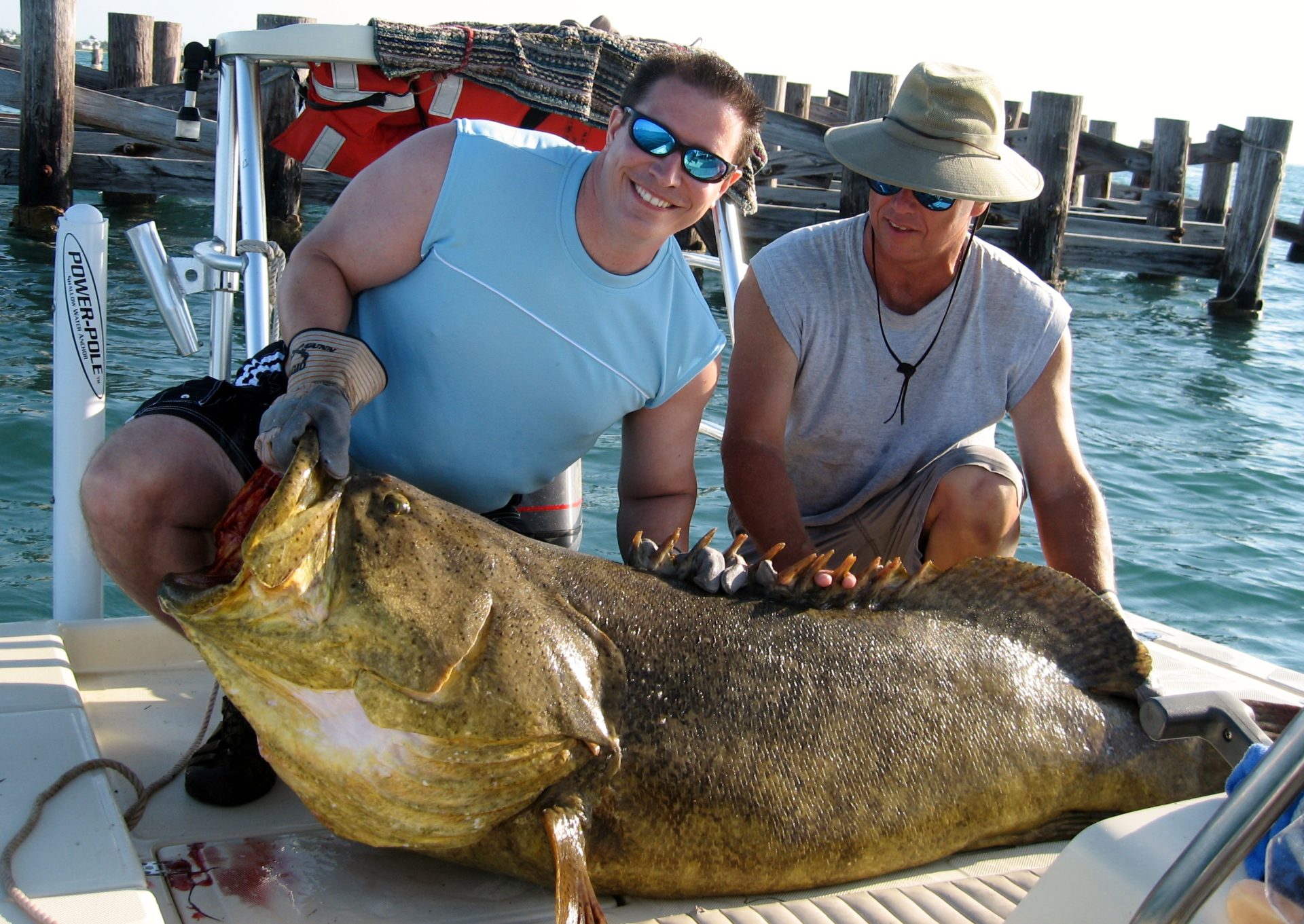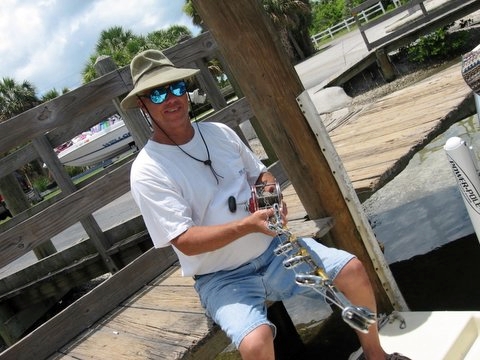SPOOL ME ONCE, SHAME ON YOU . . . by Max Hawthorne
Freshwater or salt, it’s every fisherman’s dream-turned-nightmare. You’re out doing what you love most – enjoying a fun day on the water – when the strike comes. You set the hook hard, only to watch your rod turn into an upside-down ‘U’ and line start peeling off like water from a fire hose. You grin, knowing you’re into something bigger than expected. Your eyes pop, and you give a loud whoop as your reel’s backing continues to be stripped. Your grin becomes a toothy smile. You don’t know what you’ve got on the end of your line, but you’ve definitely hooked a monster!
Your smile fades, however, when you notice your “monster” isn’t stopping.
Whatever you’ve hooked is picking up speed. Soon line is screaming off your reel so fast you can’t help but glance toward shore, absurdly wondering if someone somehow tied a speeding Corvette to the other end. Excitement is replaced by a sickening sensation, as you notice the telltale gleam of metal peeking through your spool – your backing is almost gone. Panic takes over, and you pray for the fish to stop. Your cries of exultation become screams of denial as the unthinkable occurs.
Your line runs out.
There is a massive increase in pressure, and your rod bucks hard. You hold on for dear life, straining to keep from being pulled overboard. Suddenly, a sound splits the air, like the report of a rifle, and you go flying backwards. You end up in an embarrassing heap, while your chortling friends reach for their camera phones.
The fish of a lifetime is gone, and all you’re left with is the jackhammer beat of your heart and the smell of burning gear oil. You cradle your smoking reel in trembling arms and stare forlornly out at the water, wondering aloud, “What the @%&#! was that?”
It’s enough to keep an angler awake at night.
Scenes like this happen, and more often that one might think. It may be the result of ill-preparedness, the surprise appearance of an unexpected species, or simply an outsized version of your target genus. Whatever the case, fortune favors the prepared. So let’s review some tried-and-true methods to reduce the chances of you lamenting at some waterfront bar, buying beers for anyone who will listen to your tale of “the beast that spooled me,” and increase the odds of those same people stopping by your house to gape in awe at the behemoth hanging from your den wall.
GEAR CHOICES
When faced with the omnipresent threat of encountering the “fish of a lifetime,” proper equipment choices and making the most of that equipment can spell the difference between success and failure.
1: Call long-distance. Forget the phone. I’m talking backing here, pure and simple. It’s not rocket science. Whether you’re using spinning or conventional tackle, do your homework. Pick a reel within your budget with a good drag system and the deepest spool possible, and pack that sucker tight with all the line it will hold. The more yards you have, the better your chance of having some left after a big fish’s initial run.
2: Braid yourself. No salon talk here. Lovers of monofilament may hate to admit it, but braids’ ability to pack two or even three times as much line on a spool may make switching from mono a smart move. It lets you stay in your line class, while having plenty of extra yards in case your “Mighty Joe Young” turns out to be “King Kong.” That extra backing will also prove useful, species-wise, when it comes to expecting the unexpected. Know the region you’re fishing, and what else might inhabit it. If that snook-infested section of shoreline you’re eyeing is occasionally prowled by full-grown tarpon, you might just want to plan ahead. Better to show up with a little extra line than to end up someone’s lunch.
3: Let mono be your guide. If you are using braid, use a quality monofilament backing in a comparable line class, and know how much of it you’ve got. A lot of reels require mono backing to prevent slippage anyway, but there’s a hidden plus. When a huge fish makes a blistering run and the mono shows up, it’s both a major red flag, as well as an indicator of how much line you’ve (and time) got left before you go water skiing.
4: Top off the morning! This one’s a no-brainer. Keep your spool filled to the rim with quality line, and check it often. Topping off may be a minor annoyance, but the time it takes to splice on that extra thirty of forty yards of line will pale in comparison to the endless hours of agonizing over that possible “world record” that brought you to your knees.
TECHNIQUES
Occasionally, even the deepest spool, packed tight with the most line possible, won’t be enough to stop some fish. When it comes to situations like that, applying advanced fishing techniques may save your bacon (or at least keep you from regurgitating it).
1: Pump up the jam. We’re talking drag here. The simplest way to slow a fish down is to increase drag pressure. Know your reel and its settings, and be comfortable adjusting them while feeling the heat (literally, if you’re not careful). This is easier with lever drag conventional and rear-drag spinning reels than it is with star drag conventional or front-drag spinners, but once you’re familiar with your equipment, there should be few difficulties. Increasing drag pressure from 25% of break strength to 50% (or more) may be just the ticket to inspire your watery adversary to take five. Sure, the higher drag setting comes with an increased risk of line breakage, but if that’s your only option and you’re going to lose everything anyway, it’s worth taking the chance. Once you’ve slowed the fish down and regained a few precious yards of line, back off on the drag.
2: Them’s the brakes! Sometimes your reel’s drag washers alone aren’t up to the task at hand. Today’s super-lines will often exceed your reel’s maximum drag setting. In this case, or in cases where adjusting the drag in mid-run isn’t an option, many anglers opt for a more “hands-on” approach to bolster their drag. Whether it’s cupping the spool of an out-of-control spinning reel or putting thumb or palm heel pressure (in the case of big-game models) to the fast-moving spool of a conventional, applying manual pressure can be just the ticket to stall an oversized fish before you run out of line.
When applying pressure to the spool, many anglers utilize a protective layer to shield them from the intense heat and friction. Whether it’s a fish-fighting glove equipped with Kevlar palms, or duct-tape wrapped around one’s thumb, it’s a smart move. Wildly turning spools can turn plain ol’ mono or braid into a veritable sanding wheel, peeling off layers of epidermis at light speed. Sure, in the heat of battle you may not notice it, but you will later.
Besides personal safety, when putting the brake pedal down, it pays to know your line’s break strength – and what you can get away with. One of the great advantages of mono is its inherent flexibility. Monofilament will stretch until it reaches its breaking point, and you can feel that break coming before it happens. When you do, it’s a simple matter to ease off on the pressure. By using stop-and-starts like this, you can drastically increase the resistance you’re applying, slowing down a fish and wearing it out until you turn the tide.
Note: applying manual pressure to a moving spool can be a dicey proposition. If done improperly, there is a risk of injury. That being said, know your gear and your technique. A mistake could cost you a fish – or worse – a finger.
3: Can I get a chaser with that? A common (and non-alcoholic) technique for stopping an out-of-control tuna or tarpon is chasing it down with the boat. Typically a two-person job (three, if it’s nighttime, and someone has to hold a spotlight), the technique is relatively simple; you disconnect your anchor and haul butt after the fish. The angler fighting the fish is typically positioned in the bow or off to one side, and the pilot creates a forward-facing angle between them and their quarry. As the pilot paces the fish, matching its speed, the angler reels like a maniac to regain lost line. Although the amount of drag applied to the fish is reduced at this time, it keeps the fish working and enables the angler to restart the next round with a near-full spool (and often some very fatigued arms!).
EMERGENCY TECHNIQUES
When all else fails and defeat looms on the horizon (along with hundreds of yards of your line, dangling from the jaws of some unseen monster), it’s time to get down and dirty.
1: Back it up, baby! A technique incorporated by California’s long-range tuna fleet is the use of a backup rod. When the term “backup” is mentioned, most people think of a replacement rod, brought up when your primary gear is damaged (or spooled, as the case may be). Not here. This is one of those rare instances when an angler gets to fish while holding two rods at the same time (sort of).
Large boats, either at anchor, or drifting with multiple anglers free-lining bait, are unable to chase a fleeing fish. In such cases, and when getting spooled is a foregone conclusion, a backup rod is put in play. As the astonished angler hangs on for dear life, a mate readies the backup rod, attaching it to the active rod’s reel with a clip and a short length of cable (some boats use bungee cords for their shock-absorptive qualities). Before the line on the active rod runs completely out, its drag is cranked all the way down and the angler tosses it over the side. The mate then hands the backup rod to the angler and . . . voila! The ecstatic fisherman is back in business, fighting his fish with a new rod and a new spool of line, and attempting to reel both it and his original rod back at the same time. Once the original rod is retrieved, the mate grabs it, quickly loosens the drag (to prevent line breakage), and hands it back to the angler, who exchanges it for the now unnecessary backup rod and resumes cranking.
Definitely a team sport.
2: The Hail Mary. Prayers alone won’t put call a halt to a fast-fleeing fish. You have to give the fish a reason to stop. A sphincter-tightening technique I’ve used once or twice (when out of line – and options) is putting my reel in free spool.
While this may sound like pure insanity (and it may well be), when you’re down to your last few yards of line and nothing else is working, crazy just might be your best course of action. By eliminating the resistance from your reel, the pressure on the fish is all but erased – and its desire to flee along with it. The fight-or-flight circuit breaker in the fish’s brain flips, and sometimes (mind you, the operative word is sometimes) it stops in its tracks and resumes doing what it was before you set the hook.
Granted, this is a desperation tactic (hence the name), but if getting spooled and broken off is inevitable, what have you got to lose? Just make sure you keep a good, firm grip on your rod – in case the fish decides to keep going . . .
So there you have it folks: a pocket arsenal of anti-spooling tools and techniques that might spell the difference between victory and defeat. Learn and remember them, because believe-you-me, when “Godzilla” comes a-calling, there won’t be time for second-guessing. Remember: fortune favors the prepared, and you definitely want to count yourself among the fortunate.
Otherwise, if and when you do get smoked by the fish of a lifetime, you’ll have plenty of time to ponder things as you lay there fidgeting, with the same thought running through your mind – like the last of your line through worn-out guides.
What the @%&#! was that?





